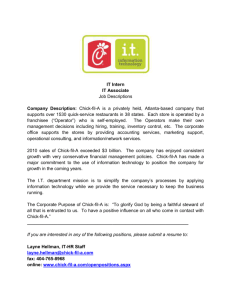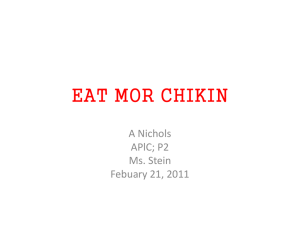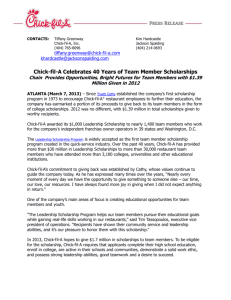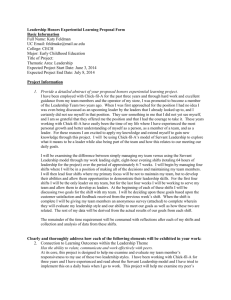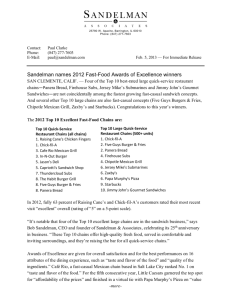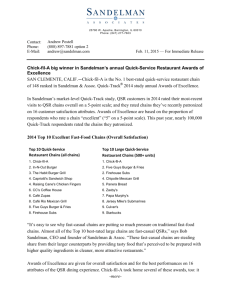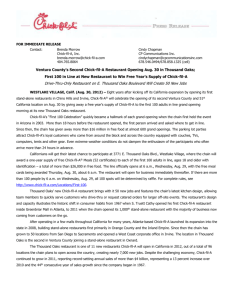Situational Analysis and Marketing Strategy
advertisement
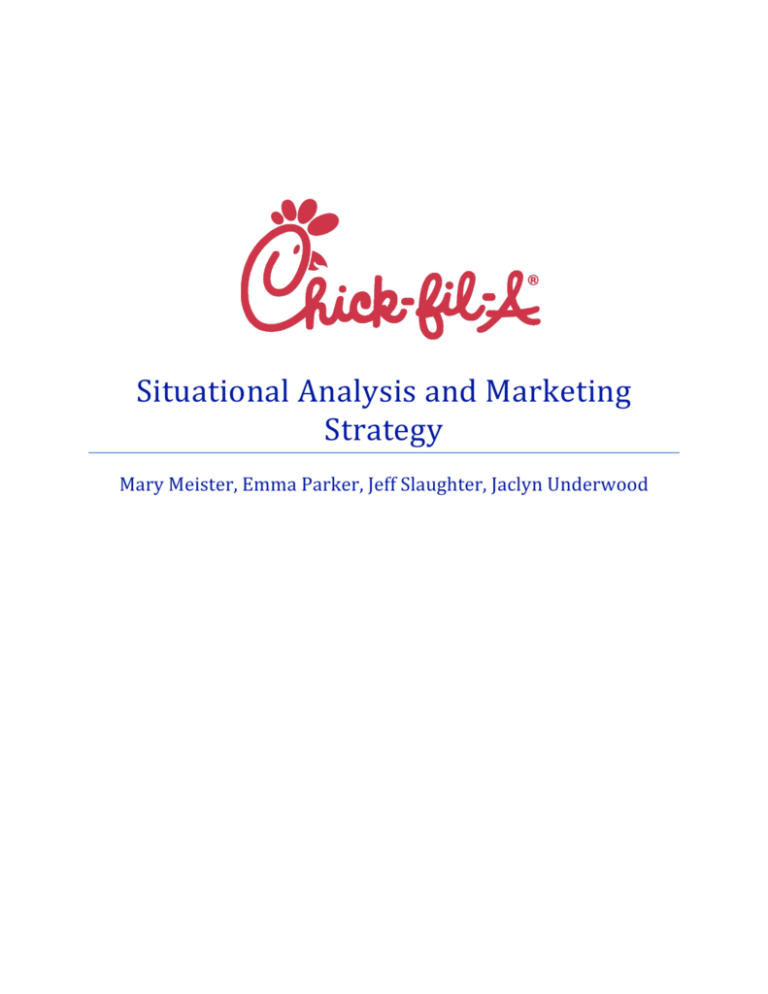
Situational Analysis and Marketing Strategy Mary Meister, Emma Parker, Jeff Slaughter, Jaclyn Underwood Chick-Fil-A: Situation Analysis Marketing Problem Chick-Fil-A is known for its production of chicken products in the chicken restaurant industry. The company has been widely recognized across the southern region of the United States which is promising. However, the marketing problem Chick-Fil-A now faces is low recognition in regions outside of the south. Chick-Fil-A needs to expand to other regions of the U.S. in order to continue their growth in the market and to ensure that the company remains a strong competitor among other chicken restaurants. Product/Brand Analysis Chick-Fil-A, Inc., headquartered in Atlanta, Georgia, is the nation's secondlargest quick-service chicken restaurant chain, currently with 1,500 restaurants in 38 states and Washington D.C. The first Chick-Fil-A was established in 1967 in Atlanta’s Greenbrair Mall by the company’s founder, Truett Cathy. ChickFil-A reached record sales of $3.2 billion in 2009 while consuming 20% of the market, which showed a 7% increase in the market share from 2004. Credited with inventing the boneless chicken breast sandwich and first introducing the chicken nugget concept, Chick-Fil-A serves nutritious and freshly prepared food products. Offerings include chicken entrees, sandwiches, salads, waffle fries and fresh-squeezed lemonade and desserts served separately and in combo meals. Chick-Fil-A serves the communities through freestanding buildings with drive-through lanes and mall-based locations. The company is also licensed to airports and schools. Trademark products include the Chick-FilA Southwest Chargrilled Salad, Cool Wrap, Original Chicken Sandwich and a line of recently introduced breakfast items. Prices range from a small order of fries for $1.35 to an original chicken sandwich for $2.75. The combo meal is also available for $5.39. The Chick-Fil-A Kid’s Meal Program includes activities to educate children in math and language arts skills and provides healthy alternatives to fries and soda for a starting price of $2.85. The Chick-Fil-A Kid’s Meal Program includes activities to educate children in math and language arts skills and provides healthy alternatives to fries and soda. The company also offers catering services with large trays of menu items. Chick-Fil-A attributes its growth over the past 30 years to dedicated franchise owners and the company’s emphasis on product quality. The company advertises through its signature cow antics, featuring ads wherein cows try to convince consumers to eat more chicken, or "chikin" as the cows spell it. In 2008, Chick-Fil-A spent $13,161,000 in general promotion advertising. As shown in Figure 1, Chick-Fil-A spends most of its advertising budget on network TV, but cable TV and spot TV also make up a large portion of advertising spending. Chick-Fil-A’s mission statement is "to glorify God by being a faithful steward of all that is entrusted to us; and to have a positive influence on all who come in contact with Chick-Fil-A.” Chick-Fil-A lives by its mission statement through their corporate sponsorships, which reflect 1 the most important core value of making a positive influence on the company’s communities and the people in them. The company has a WinShape Foundation to help kids in need through homes, camps and scholarships. Chick-Fil-A is also a proud sponsor of the Big 12 Conference, as well as the Chick-Fil-A Bowl and Chick-Fil-A Kickoff Game. Primary Competitors Analysis The KFC Corporation was founded in Louisville, Kentucky by Colonel Harland Sanders in 1952. As of 2009, KFC’s market share is 30%, decreasing by six percent since 2004. Over 12 million customers are served in over 109 countries or territories in a day. KFC specializes in Original Recipe, Extra Crispy, Kentucky Grilled Chicken, and original recipe strips served with home-style sides. KFC’s best seller, Original Recipe fried chicken is made from Colonel Sander’s secret blend of 11 herbs and spices. This recipe has remained unchanged since the beginning of the chain. The cost of a two piece original recipe or Kentucky Grilled Chicken combo is $5.97. The combo comes with chicken, a drink, and a side. KFC’s grilled chicken sandwich combo costs $4.79. It includes the sandwich, a drink, and a side. Customers can choose from 300 menu items around the world, from Kentucky Grilled Chicken in the U.S. to a salmon sandwich in Japan. Their revenue in 2008 was over $11 billion. KFC is the first fast food restaurant to introduce reusable take-out food containers. The campaign’s slogan is “reuse, renew, rejoice.” The containers are Tupperware style, microwaveable, and dishwasher safe. Also, on the KFC website, there is a petition that customers can electronically sign to try to get Colonel Sanders on a postage stamp. Popeyes first opened in Arabi, Louisiana, a suburb of New Orleans, on June 12th 1972. There are restaurants in more than 40 states and 20 countries. As of 2004, it has a market share of 10.2% of the chicken fast food market. The company’s official history states that Popeyes started off serving “tradition mild fried chicken” but business was too slow so they decided to spice up the recipe a bit to appease the pallets of New Orleanains, who love big flavor. The franchising of Popeyes started in 1976 in Baton Rouge, Louisiana. Popeyes is concentrated in the South. Ten years after Copeland began his franchising in Baton Rouge, 500 more Popeyes locations were added to the southern region. In 2006 Popeyes announced that the company planned on introducing a trans-fat free biscuit and French fries with only 1 gram of Trans fat. A two piece meal at Popeyes costs $4.99 and includes the chicken, a side, a drink, and a biscuit. In true Louisiana fashion, Popeyes has a shrimp po’boy, which costs $2.99. You can make it a combo with a drink and side for three dollars extra. In 2007, Popeyes had over $167 2 million in revenue in 2007. There is a link on the Popeyes website for store locations and coupon offers. Secondary Competitors Analysis Sonic is a fast food chain that is mainly southern. They sell chicken products, but also have burgers, hotdogs, and many other fast food favorites. Since Sonic is not just a chicken fast food restaurant, it is a secondary competitor. Sonic’s market share within the top fast food restaurants is 5.5%. it is based mainly in the South with a substantially higher index number than any other region in the U.S. Sonic is a fast food restaurant but with a twist. They employ carhops, wearing roller skates, who serve your food to you while you sit in your car. Sonic is based in Oklahoma City and as of 2009, there were 3,500 Sonic restaurants in 44 out of 50 U.S. states. Sonic’s founder, Troy N. Smith Sr., returned home from WWII to his home town of Shawnee, Oklahoma and opened a restaurant name Troy’s Pan Full of Chicken. In 1953 he added a small root-beer stand named Top Hat Drive-In to the property and was averaging $700 dollars a week from the stand’s sales in root-beer, hamburgers, and hotdogs. He changed his plan on turning the restaurant to a steakhouse and turned it all into a drive in instead. Originally people would park their cars anywhere on the gravel parking lot and walk up to the counter to order, but this all changed when Smith took a trip to Louisiana and saw driveins using speakers. Smith franchised his drive-in, in 1956, when a man named Pappe joined the business. Smith and Pappe had to change the name Top Hat after learning it was already trademarked, the two decided on the name as it is known today, Sonic. One of Sonic’s best sellers is their Coney. It is a foot long hotdog with chili and cheese. A Coney costs $2.99, or you can make it a combo with fries and a drink for $5.59. Sonic’s grilled chicken sandwich is $3.69. A grilled chicken sandwich combo is $5.59. Sonic has the SONIC Cruisers Club which is their official fan club. By being a member of the club, you receive a monthly e-mail newsletter and a surprise on your birthday. You are also able to purchase a SONIC card. This card is a reloadable card that can be used at all Sonics in place of credit cards or cash. Many people buy SONIC cards as gifts. Sonic supplies games for kids to play on their website, and a birthday club where children are able to get a free Kid’s Meal on their birthdays. Sonic also has a special happy hour from 2-4 pm where you get half-priced drinks and slushes. 3 Unlike all of our other competitors, Burger King is large not only in the South, but in every region of the U.S. It is second to McDonald’s in top burger chain market shares, controlling 13.9% of the market. It sells chicken products, but makes most of their revenue from their flame broiled burgers. Burger King is a global chain. It is headquartered in Florida. It began as a small restaurant chain in Jacksonville, Florida in 1953. Originally called Insta-Burger King, it began having financial troubles in 1955 while being run by two men named Kramer and Burns. The two men sold the chain to David Edgerton and James McLamore, who renamed the restaurant Burger King. In 2009, at the end of the fiscal year, it was reported that Burger King had more than 12,000 stores in over 73 countries, with 66% of the stores in the U.S. The company’s 37,000 employees serve over 11.4 million customers per day. The Whopper, Burger King’s trademark menu item, was added to the menu by McLamore in 1957. Burger King has tailored its menu for regional tastes. The Whopper burger costs $3.39, but if you want to add fries and a drink the cost rises to $4.99. Burger King has many chicken sandwiches, but only one they call their Original Chicken Sandwich. The cost of just the chicken sandwich is $3.79, but adding fries and a drink will cost $5.79. Burger King uses “The King” in their advertisements. “The King” is a silent, funny character and is the face of Burger King as Ronald McDonald is to McDonald’s. Burger King has also come up with the slogan, “Have It Your Way,” which implies that the company will go far beyond what other fast food chains will do to satisfy their customers. Burger King’s website has a kids club where children can play games and go on virtual adventures. They also have a BK Crown Card which is a reloadable card used to purchase items from Burger King. It is used in place of cash or credit cards. Burger King also teams up with movie studios to advertise anticipated movies. They come up with games, prizes, and dolls to help promote upcoming blockbusters. Burger King even changes the design of their cups, bags, and containers to advertise upcoming movies. Advertising Expenditure Analysis Chick-Fil-A’s total advertising budget was $22,390,400 according to “Ad $ Summary (2007-2008)”. TV advertisements account for a vast majority, over 75%, of the company’s budget. 37.1% of the ad dollars are devoted to Network TV, and 27% of the ad dollars are devoted to Spot TV. Cable TV uses 11.8 percent of the ad dollars, as well. Outdoor advertising has also been utilized and 19.6% of the budget is devoted to outdoor ads. The remainder of the ad budget is spent on national spot radio, 3.9%, and an obsolete amount, <.1%, on network radio. Finally, Chick-Fil-A spends about $117,000 a year on newspaper ads. 4 According to Figure 1.1 which was created from the information given in Table 1, ChickFil-A is second in overall SOV with 13% and Popeyes is third with an overall SOV of 4%. This is still much less than the leader KFC, who holds 83% of the overall SOV. Table 1 also gives us information about each company’s Media Mix for general promotions. KFC dominates the areas that Chick-Fil-A advertises the most in. In network and spot TV, KFC holds over 65% in each, and Chick-Fil-A holds less than 12% in each. In cable TV, KFC dominates Advertising Expenditure Summary 2007‐2008 (000)‐ General Promotions with 92.6% and Chick-Fil-A holds 7.4%. ChickFil-A holds 5.3% SOV in newspaper, but this category is also dominated by KFC. According to the Figure 1.3, Chick-Fil-A spends most of their budget utilizing TV outlets and spends the majority of their budget advertising on Network TV (57.7%). In Figure 1.2, KFC on the other hand focuses their budget on various media outlets that Popeyes and ChickFil-A do not such as Sunday Magazines (1.32%) and Outdoor (1.60%). However, the majority of their budget goes toward advertising their general promotions on Network TV (46.86%). Lastly Figure 1.4 shows that Popeyes only utilizes Newspapers and spends 98% of their budget on Spot TV for general promotion. 5 Product Life Cycle (PLC) Chick-Fil-A is in the Growth stage of the Product Life Cycle. One main reason that Chick-Fil-A is in the Growth stage is because of the company’s continuous growth in sales. Chick-Fil-A has kept a steady increase in sales since 1967, when the first Chick-Fil-A restaurant was opened. Over the course of the next 33 years, the company maintained the growth in sales and reached $1 billion in annual sales in the year 2000. Over the last decade, Chick-FilA has seen a rapid increase in sales, surpassing $2 billion in 2006. In 2009, with an 8.6% increase from the previous year’s sales, Chick-Fil-A’s annual sales rose to over $3 billion. The rapid and constant increase of sales shows that Chick-Fil-A is doing well in the Growth stage of the PLC. Along with an increase in sales, Chick-Fil-A’s number of restaurants has continued to rise each year. Chick-Fil-A is a chain restaurant, which can be beneficial in the Growth stage. Chick-Fil-A offers its food products at reasonable and fair prices, and same-store sales increased by 2.5% from 2008 to 2009. Also, the Chick-Fil-A company owns most of its restaurants, but licenses the restaurants out to franchises for a fixed annual income supplemented by a share of the in-store sale’s profit. This concept allows stores to open at a lower cost and attracts a higher number of franchises, resulting in the spread and growth of Chick-Fil-A restaurants. By adding these new stores, Chick-Fil-A can increase reach and frequency, which is a main goal during the Growth stage. Chick-Fil-A is steadily expanding and the company is second to KFC in chicken restaurant market shares. Chick-Fil-A has a strong competition with KFC and Popeye’s, and must also compete with new companies joining the market. Additionally, Chick-Fil-A faces competition from restaurants such as Burger King and Sonic in the overall fast-food market. To maintain growth, Chick-Fil-A must aim to increase market share in both markets. The company is adding products to the menu and expanding store locations to help increase sales and market share during the Growth stage of the PLC. 6 Chick-Fil-A: Marketing Strategy SWOT (Strength, Weakness, Opportunity, and Threat) Analysis Chick-Fil-A Strengths • Chick-Fil-A is very well known for having such a good chicken sandwich, which differentiates them from competitor’s whose brands are centered on plain chicken. • The Chick-Fil-A Cow’s advertising campaign has become popular and has built recognition among chicken restaurants and differentiation compared to fast food chains that serve beef or burgers. • Chick-Fil-A has had a continuous increase in annual sales over its entire lifespan. • Chick-Fil-A holds the second largest market share in the chicken restaurant market. Weaknesses • According to a tradition that started with the first Chick-Fil-A restaurant, ChickFil-A is not open on Sundays. This guarantees that every Chick-Fil-A in the nation is closed for 52 days out of the year in addition to observed holidays. Not only does this directly affect sales, but it can potentially decrease brand acceptance and recognition. • During lunch-serving hours, every meal is chicken. Chick-Fil-A offers salads and different sides during the day, and it offers meals that include bacon, ham, and sausage during breakfast hours. Customers may feel like they are limited in their choices and those that want something besides chicken are forced to order a side item or go to another restaurant. • Chick-Fil-A started and grew in the South. While the company is expanding, it is still heavily concentrated in the South. Chick-Fil-A’s presence in the western and and mid-western regions is very little to none at all. Opportunities • Chick-Fil-A is a franchise. This means that there are opportunities for individuals in every part of the nation to open restaurants. This will increase reach and frequency for the company. Also, because all of Chick-Fil-A’s franchises are still run under certain rules and restrictions set by Chick-Fil-A, the consistency and quality of the products can help build brand acceptance and attract new customers. • The foundation of Chick-Fil-A’s menu is the chicken sandwich. Chick-Fil-A recently added to their menu, including the first change to the original chicken sandwich recipe, the spicy chicken sandwich. • Chick-Fil-A is heavily involved with the sponsorship of college athletics, especially college football. The Peach Bowl was recently renamed the Chick-FilA Bowl. Chick-Fil-A will have many successful advertising opportunities during the college football bowl season. Threats • Chick-Fil-A originated in the South, but has begun to spread outwards to reach more customers. However, Chick-Fil-A’s primary competitors, KFC and Popeye’s, were also originated in the South. Both of these companies maintain strong brand loyalty among customers in the southern region. Also, Chick-Fil-A 7 • • and its primary competitors will likely be expanding in a similar direction, so there will be increased competition throughout the market. Chick-Fil-A’s primary and secondary competitors offer menus that include chicken, but also offer other options. The expansion of competitor’s menus, along with the introduction of products that are very similar to Chick-Fil-A could possibly make Chick-Fil-A’s menu look very limited to consumers. If franchise policies are not followed by the franchises, it could devalue the brand and damage the image of the company. KFC Strengths • They have the most market share of the chicken restaurant market. • They use many different types of advertising vehicles that many other competitors do not. • They are innovative due to their release of new reusable containers. Weaknesses • Although it is the top holder of the chicken restaurant market it does not appeal to all regions of the U.S. • Its menu is very specific. Opportunies • They have grilled chicken and give people healthier options to those who choose them. • They can dominate the chicken restaurant industry if they apply advertising strategies successfully. Threats • Other markets recognize their standing in the market and have high competition. • They utilize too many advertising dollars on too many products at the same time. Popeyes Strengths • Popeyes has different menu items that directly relate to Louisiana, where they first started. • According to Figure 1.1, Popeyes utilizes their advertising dollars efficiently. They have spent the least amount of money for advertising in media outlets but continue to remain a strong competitor in the market. • Popeyes has already expanded out of the South and into the mid-western region of the U.S. and have targeted males and females equally. Weaknesses • It still holds the smallest portion of the market share compared to Chick-Fil-A and KFC. • KFC is expressed as a very southern regional food. It is harder for them to attract the general population of the U.S. Opportunities 8 • A Popeyes offer shrimp po’boys on their menu, something that Chick-Fil-A or KFC does not which allows them to tap into the seafood market not just the chicken market. Threats • It could be hard for them to expand to other regions of the U.S. because they advertise themselves as specifically Louisiana food. • People with brand loyalty to places like KFC are harder to sway since they offer almost the same products. Burger King Strengths • Burger King offers flame broiled burgers where no other places offer them including big chain places like McDonalds. • Their advertising style is very aggressive in order to draw in their target audience. • They cross advertise with movie studios to promote new and upcoming movies and have very interactive promotional tools such as sweepstakes, etc. Weakness • Burger King is more of a burger oriented place; they do not offer a wide variety of chicken products like other chicken restaurants do. • They do not have very much expansion into the western region of the U.S. and they do not appeal to healthy eaters. Opportunities • They have developed a new breakfast menu that may allow their consumer growth to expand. • They have room to grow in order to appeal to healthy eaters. Threats • McDonalds still controls a huge portion of the market share and are more sensitive to consumer needs. • Brand loyalty is an issue because McDonalds is such a dominating market. Sonic Strengths • They are the only real known Drive-In fast food restaurant where food is delivered by carhops. • They are only restaurant of the top burger chain competitors that offer hot dogs, an extensive drink menu and other arrays of items. • They appeal to every age group, 18-64. Weakness • They do not have a trademark menu item. Their menu may be too expensive for some people. • They offer minimal dining in areas. Some people may not want to eat in their cars. • They are not popular in any other region except the South. Opportunities • They have the ability to specialize in a category of food such as drinks or desserts. • They can credit themselves more for being a drive in fast food restaurant. Threats 9 • If they decided to expand they would struggle since their brand does not flourish in other regions of the country besides the South. Marketing Objectives We plan to increase Chick-Fil-A’s market share from 20% of the fast food chicken market to 25% of the market by the end of our expansion to the northeast region of the U.S. We choose a 5% increase so that Chick-Fil-A has a large lead over Popeye’s in market shares, and absorbs some of KFC’s market share. Chick-Fil-A has had much success in the South. ChickFil-A must increase reach to attract new customers in new areas of the country. Also, while increasing reach, Chick-Fil-A must also increase frequency. Chick-Fil-A must increase frequency to compete with KFC and Popeye’s locally, and to raise brand awareness and try to build brand loyalty with new customers in the market. To become a primary competitor, for fast food giants like McDonald’s and Burger Kind, we need to expand our reach out of the South and into the untapped market of the Northeastern U.S. Marketing Mix Strategy Product: Chick-Fil-A will not undergo any physical changes as part of reaching our market objectives. Our product performs well in our category of fast food chicken, ranking number two in the market share. However, we want to place more emphasis on the advertising of our more nutritional products such as the Chick-Fil-A Chargrilled Salad and Cool Wraps. In addition to our healthy offerings, we want to place emphasis on the catering services with large trays of menu items for events such as tailgating, parties, and other social gatherings. Price: We decided not to decrease or increase the prices of Chick-Fil-A products. Although our prices are slightly higher than our competitors, we feel that the price difference separates us from the other products in the market. We focus on the quality and taste of our food; therefore, the prices of our products display an accurate representation of what Chick-Fil-A offers its consumers. If Chick-Fil-A were to decrease its prices, we fear that the consumers will assume that our quality has also decreased. By keeping our prices the same, we are able to continue to reach our target audience. Place: 10 Chick-Fil-A serves its communities through freestanding buildings with drive-through lanes. Stores are beginning to expand their single drive-through lanes into double drive-through lanes in an attempt to serve more consumers at a faster rate. Chick-Fil-A can also serve its communities in malls, schools and airports. We plan to establish more stores, especially in the Northeast, in order to reach more of our target audience. Promotion: We plan to promote our healthier meal options and catering trays by continuing to advertise through our top media outlet of network television. We want to take a more offensive approach in our television ads. We plan to compare ourselves to our competitors on a deeper level by emphasizing some of our distinct features that we think will help place us at the top of our market. We want to do so by creating more television ads that feature consumers choosing Chick-Fil-A over our competitors because of our healthier choices, including emphasis on our removal of all artificial trans fats from our menus and condiments. Our plan to emphasize our party platters for social events can also be used through the offensive strategy. We can promote these features while continuing to use our “eat more chikin” award winning -ad campaign. The cows will incorporate and compare each feature to our competitors in a humorous, yet direct way that will show consumers why we are better. We also plan to increase our sponsorship events. We want to promote more sports related events in hopes of attracting our target audience. Our plan is to increase Chick-Fil-A advertising during basketball games. Basketball is a commonly liked sport in the northeast. While we currently sponsor the Big 12 Conference in college football which is primarily Southeastern based, we can now attract our Northeastern target audience through basketball. By sponsoring college basketball events and college football events, we can reach a larger audience. Sponsoring sporting events gives us the opportunity to promote our tailgating and social event catering trays. Social networking is also essential for our promotion. Chick-Fil-A has a Facebook page that can be accessed through www.facebook.com/ChickfilA. This social outlet is continuing to grow in our society, which is why we need to continue our efforts to connect with our consumers over the web. Chick-Fil-A’s page consists of 3,114,978 people that have become friends with the company, giving them access to the menu, new-featured menu items and the opportunity to become a Chick-Fil-A Email Insider. A new feature to the Facebook page offers Chick-Fil-A online ordering at select locations. Consumers now have the opportunity to order their meal online. As we continue to promote our online page, the online ordering system will greatly expand. Target Selection 11 Chick-Fil-A holds 20% of the chicken restaurant market share. Our current target audience reaches females (index 141) who are within the age range of 18-44 (average index 117) who live in the Southern region of the U.S. Of this group of women are mostly of African American (index 150), Asian (index 152), and not Black or White (index 118). Those women who have children are 11% more likely to eat at Chick-Fil-A. Since it is our goal to now expand into the northeastern region of the U.S., our target audience is taken under consideration while viewing Chick-Fil-A users who live in this region. With an index number of 102 for males in the Northeast, and an index number of 98 for females in the Northeast, we want to reach both genders. These males and females are within the age range of 25-54 (average index 133). We chose to specify the race of our target audience to African Americans (index 196), and some other race (index 106) who are not White, Asian, or not Black or White. In or target audience, those who have children are 28% more likely to buy Chick-Fil-A. Our new target audience enjoys spending time with family (index 105). They also buy from companies who sponsor sports teams (index 155) and agree that lunch is more important than breakfast or dinner (index 113). Also, this target audience agrees that nutritional value is most important in a meal (index 115). Target Audience- Primary Competitors KFC KFC currently holds 30% of the chicken restaurant market share. Since it is the top competitor of this market, KFC is good primary competition for Chick-Fil-A. Choices 3 information shows that KFC’s target audience reaches females (index 110) who are within the age range of 18-64 (average index 110) and who live in the southern region of the United States (index 131). In terms of race, females who live in the southern region of the U.S. and are within the ages of 18-64, are of African American (index 181), Asian (index 130) and not Black or White (103) descent. Of this group of women those with children are 7% more likely to buy Chick-Fil-A. Popeyes Popeyes holds 10.2% of the chicken restaurant market share. Although Chick-Fil-A has a higher share than Popeyes, they remain a strong primary competitor since Popeyes has expanded their market out of the South and into the Midwest, an advantage that Chick-Fil-A has yet to achieve. Popeyes’ target audience reaches both males (index 100) and females (100) who fall within the 18-24; 35-54 (average index 115) age range. These males and females are targeted in the mid-western (index 103) and southern (index 125) Regions of the U.S. Of this group of people, African Americans (index 221), Asians (index 328) and those not Black or White (index 178) are more likely to buy Popeyes. Those who do not have children are 2% more likely to eat Popeye’s. Target Audience- Secondary Competitors 12 Burger King Burger King is one of Chick-Fil-A’s secondary competitors. Burger King is a good secondary competitor because it holds 13.9% of the top burger chains market, making it the second highest competitor in that market. These statistics are similar to those of Chick-Fil-A’s which has a market share of 13% and that is also the second largest competitor in its category. Another reason Burger King is a good secondary competitor is because they have already expanded into the northeastern region of the U.S., the same region we are interested in expanding to. Burger King’s target audience includes males (index 111) who are within the ages of 18-24; 35-54 (average index 107), live in the northeastern (index 127) and southern (index 112) regions of the U.S. and are African American (index 128) and some other race (index 107) that is not Asian, White, or not Black or White. Of this target audience those who have children are 7% more likely to buy Burger King. Sonic Sonic is another one of Chick-Fil-A’s secondary competitors. Sonic consumes 5.5% of the top burger chains market, and is the fifth largest competitor in its market. Like Chick-Fil-A, Sonic targets females (index 123) living in the southern region (index 209) of the U.S. The females targeted are within the 18-64 (average index 110) age range and are either White (index 105), Asian (index 100), not Black or White (index 100) or some other race (index 100). Those who have children in this target audience are 5% more likely to eat at Sonic. Sonic also makes a good secondary competitor because they have potential to expand out of the South since their index numbers are so high for their current target audience. 13

